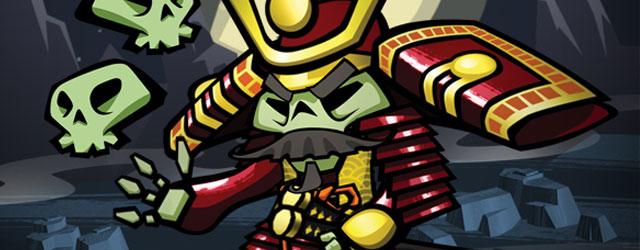[tab:Review]
I cannot tell a lie; strategy games intimidate me. With pages of rules and a plethora of unit types to learn about, the complexity can be overwhelming. Skulls of the Shogun attempts to bring turn based strategy down to a level that people like me can understand, while still maintaining the soul of the genre. With a cute art style and approachable game play, it succeeds. While it is likely too simplistic for veterans, it’s a good choice for those looking to expand their horizons.
The game begins with General Akamoto, on the verge of becoming Shogun, stabbed in the back and killed. Akamoto goes to the afterlife, where he discovers thousands of warriors in line ahead of him, all awaiting their final judgments. Not one who likes to be kept waiting, Akamoto quickly recruits others to his cause, and sets about creating an army to storm the bureaucracy governing the dead and seek vengeance for his murder.
In each stage, Akamoto and his army will face off against another general and his army. The generals are the key to battle. Although they are powerful warriors, when a general dies, the fight is over regardless of any remaining troops. Fortunately, you have three classes of soldier to fight for you (infantry, cavalry and archer), each with their own stats and abilities. Making good use of your troops and the way they interact is key to victory.
The controls in Skulls of the Shogun are simple and accessible. Select a unit and move them with the left stick as two circles display your remaining movement range. Once in range of an enemy, you can highlight it to see the damage both your attack and their counterattack are expected to do. From there, you can execute the attack or cancel the entire move, allowing you to scout different options with no penalty.
In addition to attacking, your units can haunt rice paddies to earn rice used to purchase more troops, or haunt shrines to summon different types of monk to provide healing or support in battle. Attacking, haunting and spell casting are all actions, and each unit can carry out one action per turn, with a maximum of five units performing an action per round. This limitation adds to the strategy, while the ability to preview before committing to an action is great for learning how the game works.
Defeated enemies leave their skull behind, and you can use a unit’s action to eat an enemy skull, which both heals and raises max HP for that unit. Eat three skulls, and the unit becomes a demon, gaining the ability to carry out two actions per turn. The risk/benefit of skull eating adds another layer of strategy, and also increases the importance of keeping your troops alive, since enemies can eat your fallen warriors’ skulls as well. The only disappointment is that since there is no unit persistence, a demon unit is only good for the current battle.
Right from the beginning, Skulls of the Shogun stands out with a cute, cartoonish art style. The character models are nice, and their stilted movement animations add to the charm. My one complaint about the visuals is that the main faction colors are red and purple, which made it difficult to easily distinguish my units from the opposition. The voices and battle sounds are good, and the writing has a great sense of humor. It’s always cheeky and borderline silly, and any game about a dead Japanese warrior that manages to work in a quote from Anchorman is doing something right in my book.
While the game is a nice starter for turn-based strategy newcomers, genre veterans will likely find it lacking in challenge. The AI has some very specific tendencies that can be exploited, to the point that it will occasionally make decisions that are downright dumb. In one instance, my general could have been finished off with one hit, and my opponent instead decided to move a bunch of distant units around, giving me an opening to reach the end of the level.
There are some nice multiplayer features, including support for 2-4 players locally or on Xbox live in multiple game types. The game also has a mode that supports cross-platform play and syncs your current game on Windows 8 and Windows Phone 7, allowing you to keep up with the action across several platforms (although the game must be purchased separately on each). Unfortunately, despite all of those options, I was never able to find a game online, so I wasn’t able to see how well it functioned.
Skulls of the Shogun is a cute, accessible game that’s easy to pick up and play, but adds enough depth and strategy over the course of the experience to remain entertaining. The introduction of new elements is nicely woven in, and it never felt like I was getting too much information at once. Make no mistake, this is not a game intended for the hardcore strategy crowd. It is great as a game for beginners though, and those looking for a light version of turn-based strategy will find it to be a good choice.
Review copy of game provided by publisher.
[tab:Screenshots]
[tab:END]


